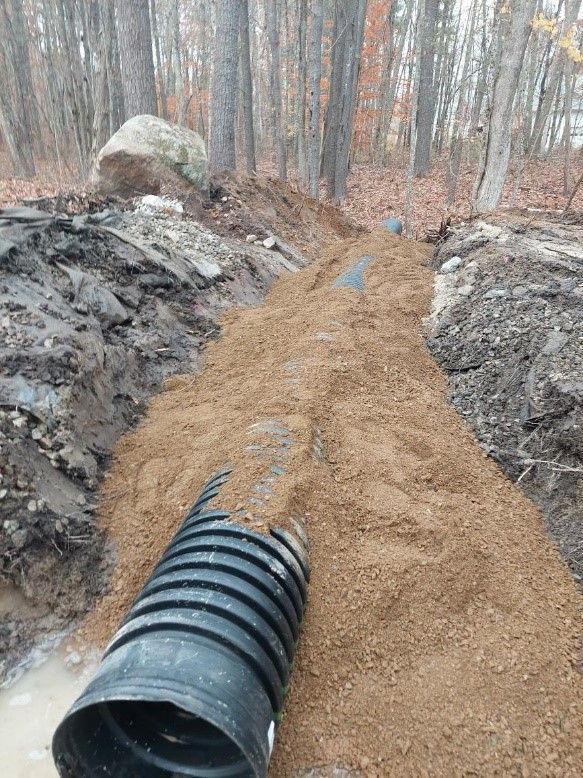Reliable Pad Construction for Your Task Demands
Reliable Pad Construction for Your Task Demands
Blog Article
Culvert Installment Made Easy: Step-by-Step Overview for Success
From choosing the proper culvert dimension to integrating proper drainage steps, each step in the installation process plays a vital function in the functionality and durability of the culvert system. Stay tuned to reveal the important actions and factors to consider that can make culvert setup a seamless and successful venture.
Choosing the Right Culvert Size
Choosing the ideal culvert dimension is critical for guaranteeing effective water flow and architectural honesty in culvert setup tasks - Pad Construction. The dimension of the culvert directly influences the circulation ability of water through the structure. A culvert that is too little can cause flooding and overflow, while one that is also big might cause reduced water speed, potentially creating debris buildup and clogs
To identify the best culvert dimension, elements such as the watershed location, height circulation rates, and hydraulic effectiveness requirement to be meticulously thought about. Calculations based on these criteria aid in choosing a size that can adequately handle the expected water quantity while decreasing the risk of clogs and structural failure.
It is necessary to seek advice from design guidelines and standards to make sure that the chosen culvert size satisfies the task demands and local regulations (Pad Construction). By selecting the right culvert dimension, project managers can maximize water circulation, protect against potential issues, and improve the overall performance and longevity of the culvert setup
Preparing the Installment Website
Efficient culvert installation demands thorough preparation of the installation website to guarantee ideal structural assistance and capability. Before commencing the installation process, it is important to clear the site of any debris, plants, or obstructions that could hinder the culvert's placement.
Furthermore, it is very important to take into consideration variables such as dirt composition, groundwater degrees, and ecological impacts when preparing the setup site. Performing a detailed site evaluation can aid determine any type of possible obstacles or threats that may affect the culvert's efficiency. By putting in the time to prepare the setup website appropriately, you can help guarantee an effective culvert installment that meets structural requirements and makes sure lasting capability.
Putting the Culvert Properly

The quality at which the culvert is positioned is crucial for keeping a correct slope for water flow. A progressive slope helps stop pooling and advertises effective drainage. In addition, the culvert should be oriented appropriately to make certain that the inlet and outlet remain in the correct locations. This alignment is important for the culvert to work properly in taking care of water flow.
Backfilling and Condensing the Dirt
Proper backfilling and compaction of the soil around the culvert is essential to ensure stability and stop possible concerns in the future. When the culvert is correctly positioned, the following essential action is to backfill the area around it with ideal material. The backfill product need to be devoid of rocks, particles, and organic matter to prevent damage to the culvert. It is advised to use granular material such as sand or gravel for backfilling, as it gives excellent drainage and compaction homes.
After placing the backfill material, it is crucial to compact it in layers of consistent thickness. Making use of a compactor or a mechanical tamper, portable the soil gently to prevent harming the culvert. Compaction helps in minimizing the opportunities of settlement and ensures uniform assistance around the culvert. It is important to compact the soil uniformly on all sides of the culvert to keep its architectural integrity.
Correct backfilling and compaction not just provide stability to the culvert however likewise help in protecting against dirt erosion and preserving the long life of the culvert system.
Making Certain Correct Drain Integration
Incorporating effective drainage solutions plays a critical function in the general functionality and durability of culvert installments. Appropriate drain combination is crucial for taking care see of water flow, protecting against erosion, and making certain the structural honesty of the culvert system. To achieve this, it is important to develop a thorough drain strategy that takes into consideration factors such as the quantity of water anticipated, the topography of the location, and the kind of dirt present.

Additionally, integrating features like disintegration control steps, such as riprap or plant life, can better boost the effectiveness of the drainage system. By very carefully intending and implementing these drainage solutions, culvert installations can work efficiently and stand up additional resources to the examination of time.
Conclusion
In verdict, correct culvert installation is crucial for preserving effective drainage systems. By choosing the right culvert size, preparing the setup website, positioning the culvert correctly, backfilling and compacting the dirt, and making sure appropriate drain assimilation, success can be achieved. Adhering to these actions will certainly aid make sure the durability and effectiveness of the culvert, eventually adding to the total success of the drainage system.
Report this page